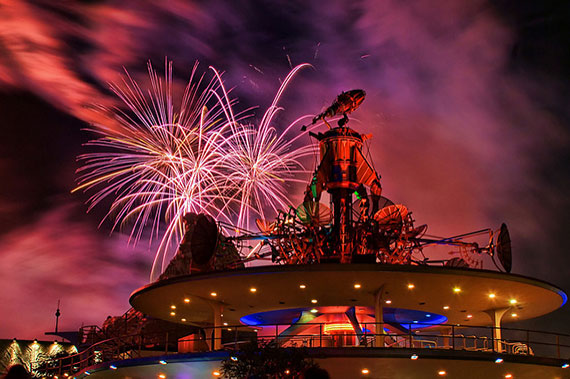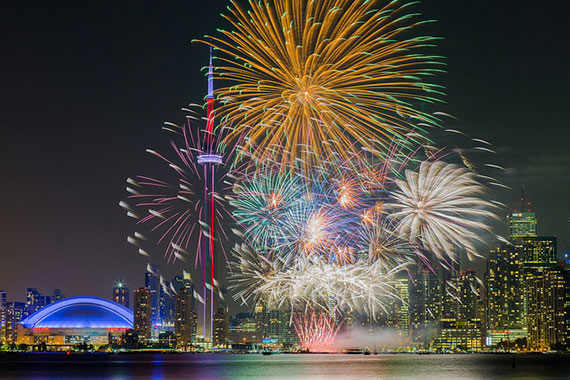We all love to see fireworks displays with the bright colors displayed against the night sky. Some of the displays can be quite spectacular. If you like taking pictures, there is no doubt that you will see the fireworks display as a great photo opportunity.

Photo by Joe Penniston; ISO 200, f/14.0, 6-second exposure.
However, if you just pick up your camera and point and shoot, you might be a little disappointed with the results.
The reason I say that is because each individual fireworks burst only lasts a couple of seconds at best in its fullest brightness and shape. By the time you see exactly where the burst is, and then try to frame it in your viewfinder and press the shutter to take the picture, it is probably already fading away.
It’s not impossible to get a picture of a fireworks burst using the camera automatic mode, but shutter lag and hoping the camera will autofocus quickly enough makes it a hit or miss deal.
The best way to photograph fireworks is to use a longer exposure time. By that I mean your camera shutter will need to stay open for a longer period of time than usual.
With a longer exposure time, your camera shutter can be open for the full time (or most of it) when the fireworks burst is visible in the sky. This will yield a much better picture than if you catch the display when it is already fading and losing its shape.
How do you set your camera for longer exposure times? If you are using a basic compact camera you will not be able to manually adjust the length of the exposure time on your camera. (I’ll talk about Digital SLR cameras next) When using a compact camera, set your camera scene mode setting to fireworks.
In the fireworks mode, the focusing will be set to infinity and the shutter speed will be set to a few seconds or so. This way the shutter will remain open long enough to record the light from the fireworks display properly. You will need to use a tripod when using this mode since the shutter will be open for a few seconds. Otherwise your pictures will be blurred from camera shake.
Using a Digital SLR: If you are using a Digital SLR camera, you will be able to manually choose the length of time the shutter will be open. Even better, if you use the “B” setting, you can open and close the shutter for any indefinite length of time you desire. Start off by trying exposure times of 1-4 seconds and adjust them as you see fit.

Photo by Duncan Rawlinson – Duncan.co – @thelastminute; ISO 200, f/9.0, 8-second exposure.
Digital SLR users should also manually set their aperture somewhere between F8 and F16. Even though the sky will be dark, the fireworks displays are quite bright and using a larger aperture opening like F3.5 will probably over expose the picture.
Use a Tripod! It is best to use a tripod to photograph fireworks displays. Since the camera shutter will be open for longer time periods, you must realize that it is almost impossible to hold a camera steady for more than 1/30 of a second. Even the slightest camera shake will result in blurred pictures.
If you don’t have a tripod when you photograph fireworks, try placing the camera on a firm, steady surface when taking the pictures. If you can’t do that, then try bracing yourself against something steady, with your arms held firmly against your body.
Be alert and Ready! The fireworks bursts happen quickly once the show begins. Try to press the shutter release just before the actual burst of the fireworks. This way you will record the full effect of the lights and colors.
Plan Ahead: Try to locate the area where the fireworks display will be most visible if possible. Try to stake out an area for yourself with a clear view of the show.
Also, try to determine if you want any landmarks or people visible in the pictures in addition to the fireworks display.
It takes good timing, planning, and practice to photograph fireworks. Use the above mentioned tips as a starting point and hopefully you will be able to get some great shots you can brag about or share with others. Good Luck!
About the Author:
For more information on photography related subjects, Keith Jones writes for https://www.easybasicphotography.com/. There are plenty of other photography tips and topics at the site to help you better understand the basics of photography.
Like This Article?
Don't Miss The Next One!
Join over 100,000 photographers of all experience levels who receive our free photography tips and articles to stay current:






I read up on this…packed my camera, lens, tripod and remote release. Got all set up. Realized when I got home and looked at my pics, then checked my lens, I shot with my 105 mm macro lens (it was on there from when I was shooting flowers earlier in the week and forgot to take it off). Wanted to use my 18-400 all around lens. Lesson learned…will remember to check lens the next time. But I did get a couple of interesting shots.
Anyone have a preference for lens used for fireworks?
Good post – I use the tungsten white balance, ISO 200 and between f11 and f16. Bulb, tripod and manual focus set by pointing at the place where they’re shot from. I get the framing visually the first few, adjust zoom to be just a bit wider. Then I watch the shooting point and when I see something going up, I open the shutter – when it looks cool, I let it shut. then I open the shutter again. Seems to work for me. Check a few for framing and if you’re staying open too short or too long you can adjust. I also shoot raw so it’s easy to adjust the contrasts etc in post. Happy Canada Day and US Independence Day, or whatever your fireworks are about – Enjoy.
Thats all lovely but what’s your ISO and WB setting ?
ryan, thanks for the very specific and succinct suggestions for settings. great.
thank you for this information on fireworks…very well put.